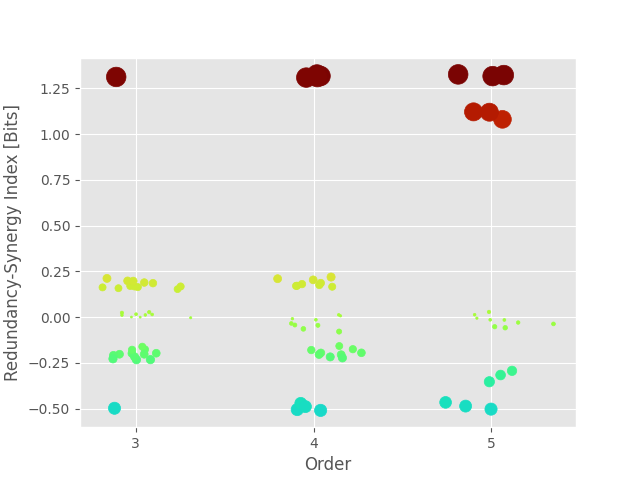Note
Go to the end to download the full example code.
Redundancy-Synergy Index#
This example illustrates how to use and interpret the Redundancy-Synergy Index (RSI).
import matplotlib.pyplot as plt
import numpy as np
from hoi.metrics import RSI
from hoi.plot import plot_landscape
from hoi.utils import get_nbest_mult
plt.style.use('ggplot')
Definition#
The RSI is a multivariate measure of information capable of disentangling whether a subset of a variable X` carry either redundant or synergistic information about a variable Y. The RSI is defined as :
with :
Positive values of RSI stand for synergy while negative values of RSI reflect redundancy between the X and Y variables.
Simulate univariate redundancy#
A very simple way to simulate redundancy is to observe that if a triplet of variables \(X_{1}, X_{2}, X_{3}\) receive a copy of a variable \(Y\), we will observe redundancy between \(X_{1}, X_{2}, X_{3}\) and \(Y\). For further information about how to simulate redundant and synergistic interactions, checkout the example How to simulate redundancy and synergy
# lets start by simulating a variable x with 200 samples and 7 features
x = np.random.rand(200, 7)
# now we can also generate a univariate random variable y
y = np.random.rand(x.shape[0])
# we now send the variable y in the column (1, 3, 5) of x
x[:, 1] += y
x[:, 3] += y
x[:, 5] += y
# define the RSI model and launch it
model = RSI(x, y)
hoi = model.fit(minsize=3, maxsize=5)
# now we can take a look at the multiplets with the highest and lowest values
# of RSI. We will only select the multiplets of size 3 here
df = get_nbest_mult(hoi, model=model, minsize=3, maxsize=3, n_best=3)
print(df)
0%| | 0/3 [00:00<?, ?it/s]
33%|███▎ | RSI order 3: 1/3 [00:00<00:00, 2.26it/s]
67%|██████▋ | RSI order 4: 2/3 [00:00<00:00, 2.94it/s]
100%|██████████| RSI order 5: 3/3 [00:00<00:00, 3.17it/s]
index order hoi multiplet
0 5 3 0.010098 [0, 2, 3]
1 27 3 0.009364 [2, 3, 6]
2 11 3 0.008568 [0, 3, 6]
3 26 3 -0.189541 [2, 3, 5]
4 31 3 -0.193685 [3, 4, 5]
5 20 3 -0.379484 [1, 3, 5]
as you see from the printed table, the multiplet with the lowest (i.e. the most redundant multiplets) is (1, 3, 5).
Simulate multivariate redundancy#
In the example above, we simulated a univariate \(Y\) variable (i.e. single column). However, it’s possible to simulate a multivariate variable.
# simulate x again
x = np.random.rand(200, 7)
# simulate a bivariate y variable
y = np.c_[np.random.rand(x.shape[0]), np.random.rand(x.shape[0])]
# we introduce redundancy between the triplet (1, 3, 5) and the first column of
# Y and between (0, 2, 6) and Y
x[:, 1] += y[:, 0]
x[:, 3] += y[:, 0]
x[:, 5] += y[:, 0]
x[:, 0] += y[:, 1]
x[:, 2] += y[:, 1]
x[:, 6] += y[:, 1]
# define the RSI, launch it and inspect the best multiplets
model = RSI(x, y)
hoi = model.fit(minsize=3, maxsize=5)
df = get_nbest_mult(hoi, model=model, minsize=3, maxsize=3, n_best=3)
print(df)
0%| | 0/3 [00:00<?, ?it/s]
33%|███▎ | RSI order 3: 1/3 [00:00<00:00, 3.34it/s]
67%|██████▋ | RSI order 4: 2/3 [00:00<00:00, 4.43it/s]
100%|██████████| RSI order 5: 3/3 [00:00<00:00, 4.98it/s]
index order hoi multiplet
0 11 3 -0.305800 [0, 3, 6]
1 8 3 -0.569149 [0, 2, 6]
2 20 3 -0.573858 [1, 3, 5]
This time, as expected, the two most redundant triplets are (1, 3, 5) and (0, 2, 6)
Simulate univariate and multivariate synergy#
Lets move on to the simulation of synergy that is a bit more subtle. One way of simulating synergy is to go the other way of redundancy, meaning we are going to add features of X inside Y. That way, we can only retrieve the Y variable by knowing the subset of X.
# simulate the variable x
x = np.random.rand(200, 7)
# synergy between (0, 3, 5) and 5
y = x[:, 0] + x[:, 3] + x[:, 5]
# define the RSI, launch it and inspect the best multiplets
model = RSI(x, y)
hoi = model.fit(minsize=3, maxsize=5)
df = get_nbest_mult(hoi, model=model, minsize=3, maxsize=3, n_best=3)
print(df)
0%| | 0/3 [00:00<?, ?it/s]
33%|███▎ | RSI order 3: 1/3 [00:00<00:00, 3.97it/s]
67%|██████▋ | RSI order 4: 2/3 [00:00<00:00, 5.19it/s]
100%|██████████| RSI order 5: 3/3 [00:00<00:00, 5.80it/s]
index order hoi multiplet
0 10 3 1.273890 [0, 3, 5]
1 12 3 0.315670 [0, 4, 5]
2 14 3 0.314976 [0, 5, 6]
3 17 3 -0.001248 [1, 2, 5]
4 25 3 -0.001624 [2, 3, 4]
5 15 3 -0.001651 [1, 2, 3]
as we can see here, the highest values of higher-order interactions (i.e. synergy) is achieved for the multiplet (0, 3, 5). Now we can do the same for multivariate synergy
# simulate the variable x
x = np.random.rand(200, 7)
# simulate y and introduce synergy between the subset (0, 3, 5) of x and the
# subset (1, 2, 6)
y = np.c_[x[:, 0] + x[:, 3] + x[:, 5], x[:, 1] + x[:, 2] + x[:, 6]]
# define the RSI, launch it and inspect the best multiplets
model = RSI(x, y)
hoi = model.fit(minsize=3, maxsize=5)
df = get_nbest_mult(hoi, model=model, minsize=3, maxsize=3, n_best=3)
print(df)
0%| | 0/3 [00:00<?, ?it/s]
33%|███▎ | RSI order 3: 1/3 [00:00<00:00, 3.61it/s]
67%|██████▋ | RSI order 4: 2/3 [00:00<00:00, 4.78it/s]
100%|██████████| RSI order 5: 3/3 [00:00<00:00, 5.35it/s]
index order hoi multiplet
0 18 3 1.559214 [1, 2, 6]
1 10 3 1.381920 [0, 3, 5]
2 23 3 0.225347 [1, 4, 6]
3 32 3 -0.001482 [3, 4, 6]
Combining redundancy and synergy#
# simulate the variable x and y
x = np.random.rand(200, 7)
y = np.random.rand(200, 2)
# synergy between (0, 1, 2) and the first column of y
y[:, 0] = x[:, 0] + x[:, 1] + x[:, 2]
# redundancy between (3, 4, 5) and the second column of x
x[:, 3] += y[:, 1]
x[:, 4] += y[:, 1]
x[:, 5] += y[:, 1]
# define the RSI, launch it and inspect the best multiplets
model = RSI(x, y)
hoi = model.fit(minsize=3, maxsize=5)
df = get_nbest_mult(hoi, model=model, minsize=3, maxsize=3, n_best=3)
print(df)
# plot the result at each order to observe the spreading at orders higher than
# 3
plot_landscape(
hoi,
model,
kind="scatter",
undersampling=False,
plt_kwargs=dict(cmap="turbo"),
)
plt.show()

0%| | 0/3 [00:00<?, ?it/s]
33%|███▎ | RSI order 3: 1/3 [00:00<00:00, 3.60it/s]
67%|██████▋ | RSI order 4: 2/3 [00:00<00:00, 4.77it/s]
100%|██████████| RSI order 5: 3/3 [00:00<00:00, 5.35it/s]
index order hoi multiplet
0 0 3 1.312485 [0, 1, 2]
1 16 3 0.211186 [1, 2, 4]
2 15 3 0.197775 [1, 2, 3]
3 10 3 -0.232792 [0, 3, 5]
4 20 3 -0.233146 [1, 3, 5]
5 31 3 -0.498634 [3, 4, 5]
Total running time of the script: (0 minutes 3.920 seconds)
